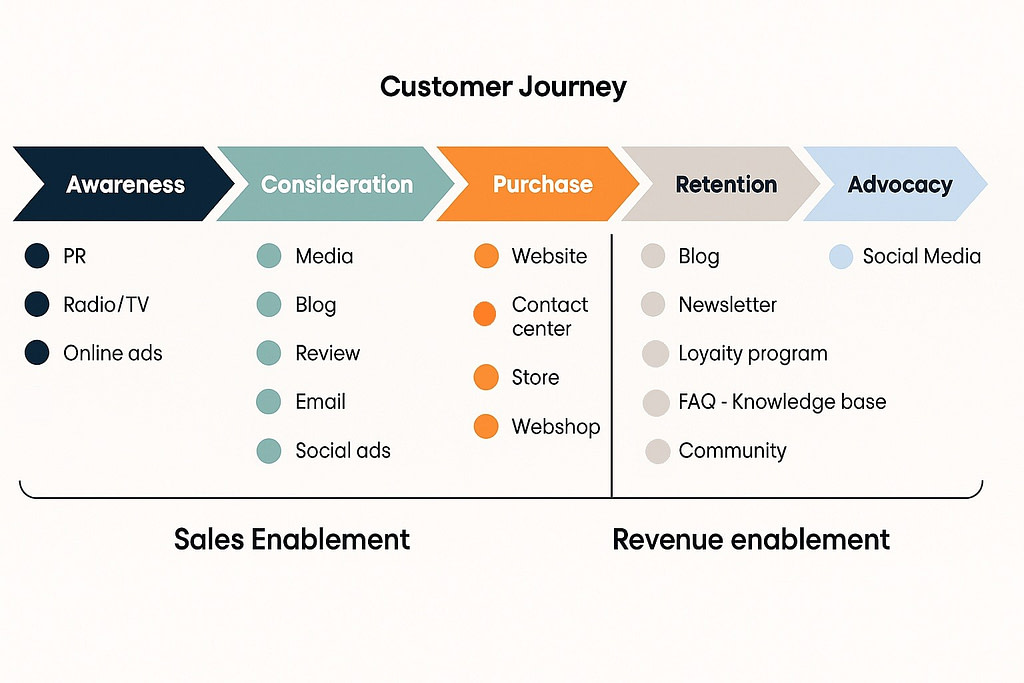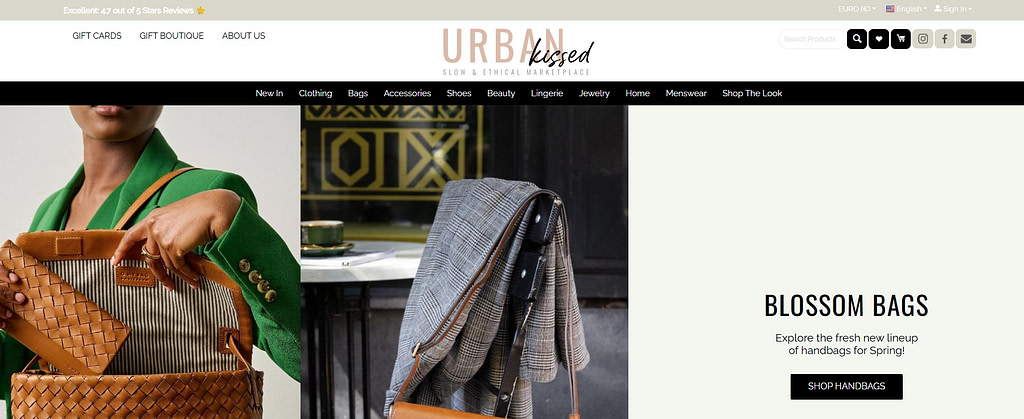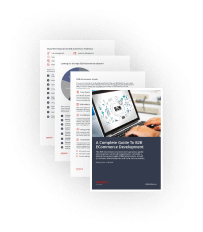According to Forrester, companies that align marketing, sales, and customer success teams can achieve up to 36% higher customer retention and 38% higher sales win rates. Yet, only 8% of B2B organizations say their go-to-market teams are tightly aligned.
This gap in alignment has paved the way for a more holistic approach: revenue enablement.
1. Revenue enablement focuses on aligning all customer-facing teams—sales, marketing, customer success, and partners—around shared goals to enhance revenue generation. This approach contrasts with traditional sales enablement, which primarily supports the sales team.
2. Effective revenue enablement relies on creating scalable workflows that deliver a consistent customer experience. It emphasizes the importance of using data and feedback to refine processes and measure success through shared KPIs like customer lifetime value (CLV) and customer acquisition cost (CAC).
3. Revenue enablement emphasizes the importance of integrating various tools and technologies used by different customer-facing teams. By connecting CRM systems, analytics platforms, and content management tools, organizations can create a unified ecosystem that facilitates seamless communication and collaboration.
What is Revenue Enablement?
Revenue enablement is a company-wide approach to driving revenue generation and growth by aligning all customer-facing teams—sales, marketing, customer success, and partners—around shared goals. Unlike traditional sales enablement, which equips only the sales team with tools and training, revenue enablement ensures every team has access to unified processes, insights, and content to deliver a consistent and valuable customer experience across the entire lifecycle. Revenue enablement works by helping teams work together and talk to customers in the same way.
Revenue Enablement vs. Sales Enablement
Sales enablement equips sales teams with resources to close deals.
Revenue enablement is a broader discipline that includes all customer-facing roles and is focused on driving overall revenue growth, not just individual deal success.
Where sales enablement is often reactive and focused on the sales funnel, revenue enablement is strategic and cross-functional, ensuring that marketing, sales, and post-sale teams are aligned around customer needs and business objectives.

To better understand the impact of revenue enablement vs sales enablement, let’s compare their scope, objectives, and metrics side by side.
| Aspect | Sales Enablement | Revenue Enablement |
| Scope | Sales team only | Entire revenue team |
| Objective | Close more deals | Drive end-to-end revenue growth |
| Tools | Playbooks, CRM training | Cross-team workflows, analytics, shared content |
| Metrics | Sales productivity, win rate | Revenue growth, customer retention, NPS |
Is Revenue Enablement Process-Based?
Yes. Revenue enablement is deeply rooted in process optimization. It involves creating repeatable, scalable workflows that help every revenue-generating team deliver a consistent and personalized customer experience. From onboarding new reps faster to aligning marketing campaigns with sales motions, process is the backbone that makes enablement measurable and effective.
Why Should You Implement Revenue Enablement?
Revenue enablement is a strategic response to shifting market dynamics and customer expectations. It also plays a central role in growth enablement by aligning people, processes, and tools to drive scalable, sustainable business expansion. Here’s why adopting a revenue enablement strategy has become essential for modern organizations.
Changing Buying Behavior and Complexity
Today’s buyers are more informed, cautious, and collaborative than ever. According to Gartner, 77% of B2B buyers report that their latest purchase was very complex or difficult. Buyers now engage with multiple stakeholders, perform independent research, and interact with several departments across a vendor organization before making a decision.
This complexity demands a unified, coordinated experience from the first touchpoint through post-sale. Revenue enablement ensures consistency and value across every stage of the customer journey—regardless of whether the buyer is speaking with marketing, sales, or customer success.
Get more insights on creating a unified experience for customers from our case study: How to Implement an Omnichannel Approach in the Furniture Business
Lack of Trust in Sales
Trust in sales teams is declining. A HubSpot study found that only 3% of buyers consider salespeople trustworthy, while 81% trust recommendations from family and friends, and 55% trust online reviews. This lack of trust means that sales reps alone can no longer carry the relationship.
Revenue enablement empowers every customer-facing team to build credibility by delivering helpful, relevant, and timely insights—establishing trust not just during the sale, but throughout the entire lifecycle. In this way, revenue enablement becomes a key pillar of business enablement, ensuring that operational, strategic, and customer-facing efforts are aligned.
Learn about other ways to create trust with customers: eCommerce Trust | How to Build Trust in an eCommerce Store
The Shift from Sales Enablement to Revenue Enablement
Traditional focus on sales often means work in silos, with narrow KPIs and limited integration with other functions. As go-to-market strategies develop, organizations are realizing that maximizing revenue requires more than just better-trained sales reps. It requires cross-functional collaboration.
Revenue enablement focuses on collaboration and alignment across all go-to-market functions to unlock shared growth potential. It’s no longer just about enabling sales—it’s about enabling revenue.
How Revenue Enablement Drives Business Growth
Companies that implement a robust revenue enablement strategy experience:
- Faster sales cycles. Unified messaging and better-qualified leads reduce friction in the customer journey.
- Higher win rates. Teams are aligned around buyer pain points and value messaging.
- Improved customer retention. Customer success is equipped with the same context and insights as sales and marketing.
- Stronger ROI on enablement programs. Investments in content, training, and tools are leveraged across departments, not confined to sales.
When done right, revenue enablement becomes a growth engine that maximizes team efficiency and creates a seamless customer experience. It ensures all revenue-generating functions work together cohesively toward shared goals, stronger customer relationships, and consistent revenue growth.
Who Benefits from Revenue Enablement?
Revenue enablement is a win-win strategy for every stakeholder involved in generating and sustaining revenue. Here’s how it impacts key roles:
Sales
Sales teams gain:
- Access to centralized, up-to-date content
- Improved onboarding and ramp times
- Data-driven insights into buyer behavior
- Better collaboration with marketing and customer success
This enables reps to spend less time searching for resources and more time selling.
Marketing
Marketing benefits from:
- Clarity on what content drives revenue
- Tighter alignment with sales goals
- Feedback loops that improve campaign effectiveness
- Enhanced content usage and ROI
Instead of pushing content blindly, marketers are now strategic partners in the revenue process.
Customer Success
Customer success teams are empowered with:
- Historical context from the sales process
- Proactive insights to identify churn risks
- Tools to upsell and cross-sell more effectively
- Consistent messaging across onboarding and support
This leads to stronger relationships, better renewals, and more advocacy.
Partners
Channel partners and resellers often struggle with inconsistent enablement. Revenue enablement provides them with:
- Standardized playbooks and messaging
- On-demand training and tools
- Support that mirrors internal sales teams
This helps extend your brand promise and performance beyond your direct organization.
Buyers
At the end of the day, the buyer is the biggest beneficiary. With revenue enablement, they receive:
- A consistent, value-driven experience across every interaction
- Faster, more relevant responses to their needs
- Confidence in your brand as a trusted advisor—not just a vendor
When buyers feel understood and supported, they’re more likely to buy—and stay loyal.
How to Build a Revenue Enablement Strategy
Adopting revenue enablement requires a structured approach tailored to your organization’s size, industry, and maturity level. Below are the instructions on how to begin building a strategy that aligns your teams and accelerates growth.
Assess Your Current Background
Start by auditing your existing revenue enablement efforts to identify gaps in alignment and execution. Are sales, marketing, and customer success aligned? Is your content centralized and accessible? Do teams have visibility into the full customer journey?
Align Teams Around the Customer Journey
To make revenue enablement work across departments, companies need to rethink how teams collaborate around the customer. Instead of optimizing isolated processes within sales, marketing, and customer teams, shift focus to shared customer experiences. Start by identifying when and how each team interacts with buyers, and establish clear handoffs, goals, and responsibilities. This customer-centric alignment ensures that every touchpoint adds value and contributes to long-term revenue growth.
Introduce Well-Defined Specific Goals and Metrics
Success in revenue enablement is measured, not assumed. Define shared KPIs that reflect alignment and impact—such as lead conversion rates, customer acquisition cost (CAC), customer lifetime value (CLV), and time-to-value.
More on this subject is in the article: How to Increase Customer LTV for eCommerce?
Enable Cross-Team Collaboration
Break down silos by creating regular cross-functional meetings, shared content repositories, and aligned messaging frameworks. Encourage open feedback loops and continuous learning across departments using team collaboration software. Cross-team alignment and internal collaboration are at the heart of most successful revenue enablement strategies. When departments work together seamlessly, they can identify opportunities faster and maximize revenue through coordinated actions.
Consider Your Company’s Maturity Stage
A startup’s approach to revenue enablement will differ from that of a scaling enterprise. Start simple—prioritize foundational tools, communication, and buyer understanding. As your organization matures, layer in analytics, automation, and advanced coaching systems.
Technology and Tools for Revenue Enablement
Technology is the backbone of a successful revenue enablement strategy. The right revenue enablement tools can accelerate collaboration, boost buyer engagement, and provide the insights needed to make data-driven decisions.
CRM and Customer Analytics
A powerful Customer Relationship Management (CRM) platform is essential. It should integrate with marketing, sales, and support tools to provide a 360° view of each customer.

If your business operates on CS-Cart software, Simtech Development can support your goals through CRM integrations, analytics, and custom revenue enablement services tailored to your specific business needs.
Marketing Automation and Content Management
Tools like HubSpot, Marketo, or ActiveCampaign help automate lead nurturing, campaign tracking, and content delivery. A well-organized Content Management System (CMS) ensures your teams always have the right resources at the right time.
Sales Enablement Platforms
Revenue enablement platforms such as Highspot, Seismic, or Showpad and other Highspot alternatives centralize content, manage training materials, and include powerful reporting tools to measure engagement across teams. They help sellers understand what content works—and when to use it.
Sales Coaching & Training Tools
Platforms like Lessonly, Allego, or Brainshark deliver structured training, onboarding, and ongoing coaching at scale. These tools are critical for reinforcing best practices and ensuring consistency. As a key part of revenue enablement technology, they help teams continuously improve performance through analytics and targeted learning.
Best Practices for Revenue Enablement
Map Key Customer Touchpoints
Revenue enablement begins with a deep understanding of the customer journey. A key principle of enablement in business is aligning internal processes to match external expectations—and that starts with knowing your customer. Mapping key touchpoints—from initial awareness to onboarding and retention—helps identify where each team interacts with the customer and how to deliver a seamless, consistent experience.
This exercise should involve stakeholders across marketing, sales, customer success, and product teams to ensure alignment and eliminate blind spots. When done right, it reveals gaps, redundancies, and opportunities for meaningful engagement.
Empower Teams Through Enablement Training
Training is not a one-time event. Ongoing, role-specific enablement ensures every team member understands how to engage customers effectively. This includes:
- Buyer personas and use cases
- Product knowledge and messaging
- Industry trends and competitive positioning
- Tools and platforms used in daily workflows
Modern organizations implement structured onboarding, microlearning, and just-in-time content delivery to ensure teams can adapt quickly to change and stay aligned.
Optimize Processes Through Data and Feedback
Data-driven revenue enablement is more effective and scalable. Use both quantitative and qualitative feedback to assess how enablement content, messaging, and tools are performing. Key inputs include:
- Sales performance data (e.g., win rates, average deal size)
- Content engagement metrics
- Customer satisfaction surveys and Net Promoter Score (NPS)
- Internal team feedback on usability and effectiveness
Continuous feedback loops help refine processes and keep enablement aligned with market realities.
Track Revenue Metrics and Iterate
The ultimate goal of revenue enablement is to improve measurable business outcomes. Track revenue-related KPIs such as:
- Sales velocity
- Pipeline conversion rates
- Customer acquisition cost (CAC)
- Customer lifetime value (CLV)
- Churn and upsell rates
Use these metrics not just for reporting, but to continuously improve your strategy, content, and training. Revenue enablement should evolve in lockstep with changing customer behaviors and market conditions to help identify and close more sales opportunities.
Revenue Enablement Examples and Case Insights
Here at Simtech Development, we’ve done many industry-specific modernizations to help companies improve their revenue enablement. Here are some cases.
Faly Music: Achieving a 150% Sales Increase through Secure Payment Integration

Faly Music, a leading Mexican store for branded musical instruments, faced a critical challenge in finding a secure and reliable payment processor that would build customer trust and prevent fraud. After testing integrations from two different development companies, only Simtech Development’s solution met their high security and usability expectations. This integration proved transformative, driving a remarkable 150% increase in sales within just one month. Over the following three months, Faly Music sold nearly 80% of the previous year’s total sales, significantly accelerating their growth trajectory. Additionally, strategic alliances with suppliers, expanded product catalogs, and improved customer communication contributed to sustained growth, with expectations to increase sales by 130-150% year-over-year. This success underscores how the right technological partnership can unlock substantial revenue gains even in challenging markets.
Urbankissed: Doubling Vendor Numbers to Boost Marketplace Growth

Urbankissed, a Swiss marketplace specializing in slow and ethical fashion, partnered with Simtech Development to bring its founder’s vision to life through the integration of over 15 custom add-ons. This technical support enabled Urbankissed to scale its platform effectively, resulting in the number of vendors doubling from 50 to 100 within a year. The marketplace’s commitment to sustainability and quality, combined with Simtech Development tech support allowed the founder to focus fully on business growth without worrying about technical issues. This vendor growth expanded Urbankissed’s product range and market presence, reinforcing its position as a leading eco-conscious fashion destination.
European Garden Equipment Company: Optimizing Dealer Network with ERP Integration
A leading European garden equipment company partnered with Simtech Development to integrate their corporate ERP system with their dealer network. This integration provided real-time visibility into orders and inventory across multiple dealers, enhancing coordination and reducing delays. With improved data flow and order accuracy, the company optimized supply chain management and marketing efforts. The streamlined operations lowered costs and elevated customer experience, driving increased sales revenue and strengthening the company’s market position.
In all these examples, companies reached revenue enablement by adding more automation for a clear, unified view of their internal operations. This approach is great when supported by a reliable technological partner that can advise the right tools and assume the tech implementation. That’s why choosing an experienced revenue enablement solutions provider is key to achieving long-term business impact and scalability.
Revenue Enablement Mistakes to Avoid
Any approach can be effective when implemented properly. Follow the best practices and avoid mistakes.
Siloed Teams and Poor Collaboration
One of the biggest blockers to successful enablement is lack of collaboration. If marketing, sales, and customer success operate in silos, the customer experience becomes fragmented. Avoid this by fostering shared goals, regular communication, and mutual accountability.
Inconsistent Tools or Metrics
Using disconnected platforms or tracking different KPIs across teams creates confusion and inefficiency. Ensure your teams use integrated tools and align on a single source of truth for measuring impact.
Resistance to Organizational Change
Successful enablement initiatives depend on cultural transformation and executive buy-in. Teams may resist new processes, tools, or reporting structures. Executive sponsorship, change management support, and clear communication about the benefits are essential to overcome resistance and drive adoption.
How to Choose a Revenue Enablement Platform or Vendor
As mentioned earlier, opting for the right technology partner is critical to the success of your revenue enablement strategy.
What to Look For in a Solution
- Cross-functional usability. Can the tool be effectively used by sales, marketing, and customer success?
- Scalability. Does it support your company’s growth and evolving needs?
- Ease of use. Is the UI intuitive for daily users? Will adoption be frictionless?
Key Features and Integration Capabilities
- CRM and marketing automation integration
- Content management and delivery
- Sales training and onboarding support
- Performance analytics and dashboards
- Collaboration tools (e.g., shared playbooks, notes, coaching)
Ensure the platform integrates with your existing tech stack and complements your workflows.
Questions to Ask Vendors
When evaluating a revenue enablement vendor, be sure to ask:
- How does your platform support multi-team collaboration (sales, marketing, customer success team)?
- Can you show us use cases where clients improved revenue outcomes?
- What integrations are available with our existing CRM and CMS tools?
- How do you support onboarding, training, and customer success teams?
- What’s the average time to implement the MVP and start seeing value?
The Role of a Revenue Enablement Manager
As revenue enablement becomes a strategic priority, many organizations are appointing Revenue Enablement Managers to lead the charge. This role is important as it bridges the gap between siloed departments and ensures a unified approach to customer engagement and revenue growth. This person collaborates closely with company leadership to align enablement efforts with the company’s sales strategy and revenue goals.
Key Responsibilities
- Cross-Functional Alignment. Collaborates with sales, marketing, customer success, and product teams to align messaging, processes, and goals.
- Enablement Program Design. Develops and manages training programs, onboarding tracks, and certification paths for revenue teams.
- Content Strategy. Ensures that the right content is created, curated, and delivered at the right time in the buyer’s journey.
- Tool and Platform Management. Oversees the tech stack that supports revenue enablement—CRM, CMS, analytics, and training tools.
- Performance Tracking. Monitors KPIs such as sales productivity, content usage, onboarding effectiveness, and pipeline velocity to drive continuous improvement.
Essential Skills
- Strong project management and communication skills
- Deep understanding of the B2B sales cycle and customer journey
- Data literacy and analytical mindset
- Experience with enablement technologies and CRM systems
- Ability to influence and lead cross-functional initiatives
The Revenue Enablement Manager plays a strategic role. This individual directly influences business growth and team performance.
Conclusion
Revenue enablement is a competitive necessity in today’s complex, buyer-driven market. It allows companies to orchestrate meaningful customer interactions across all departments, creating a consistent brand experience. By aligning all revenue-generating functions, optimizing processes with data, and enabling every team member to deliver consistent value, organizations can drive predictable growth and deeper customer loyalty.
Implementing revenue enablement requires thoughtful planning, the right tools, and a cultural shift toward cross-functional collaboration. When executed well, it becomes a powerful engine for revenue performance and customer satisfaction.
From onboarding to pipeline management, every component of revenue enablement contributes to scalable growth. Whether you’re just starting to explore revenue enablement or looking to optimize an existing program, the key is to stay focused on the customer journey, commit to data-driven iteration, and empower your people to work together toward a shared outcome: sustainable revenue growth. Our team at Simtech Development understands the business needs and technical challenges that online business owners face. We offer case-specific solutions and tools that help you avoid revenue loss. Our clients win trade-shows, get financing, and optimize their existing workflows, all thanks to our consolidated team of eCommerce experts, business analysts, professional developers and testers.

